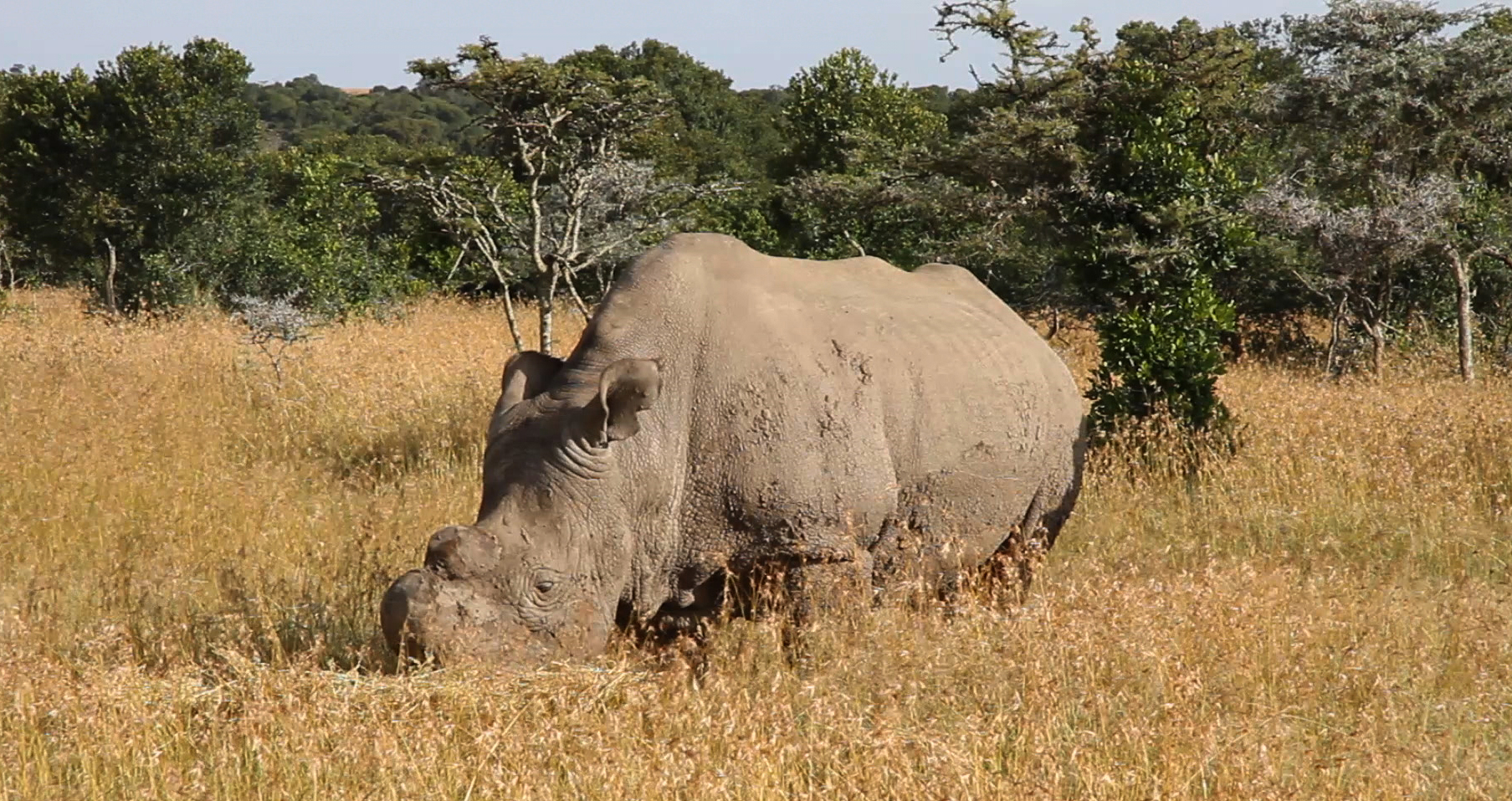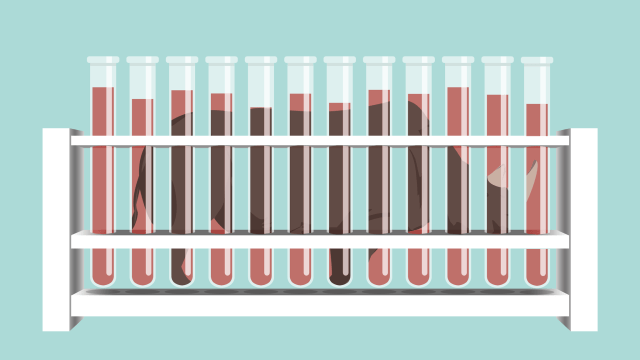In a lush conservation park in central Kenya, the world’s last three northern white rhinos are unable to breed. When they die, the subspecies will go extinct. That is unless a complex, controversial plan involving tissue cryobanks and test tube embryos can actually work.
After decades of poaching, a subspecies which once numbered in the thousands across central Africa has been reduced to just three individuals: 42 year-old Sudan, his 26-year old daughter Najin, and her 15-year old daughter Fatu. Sudan has a low sperm count. Fatu has a disorder that prevents embryos from implanting in her uterus. Najin’s weak hind limbs render her unable to support the weight of another pregnancy. Thirty years ago, the northern white rhino would have been doomed to extinction. Today, synthetic biology may offer a future.
“We know it is going to be difficult, but we feel it’s important to try to prevent this animal from going extinct,” said Oliver Ryder, a geneticist at the San Diego Zoo. “And we think this is within the realm of possibility.”
Ryder is part of the international team of scientists behind a radical new effort to rebuild the northern white rhino population with lab-grown embryos created from frozen tissue. The project, outlined this week in the journal Zoo Keys, is experimental, expensive, and fraught with uncertainty. It raises tough questions about how we should be spending our conservation dollars. And if we can pull it off, it will be one of biotechnology’s greatest achievements.
Since the remaining northern white rhinos cannot breed naturally, the process must be started in the lab. The first step will be to obtain viable gametes (sperm and eggs). Although neither Fatu nor Najin can bear young, both rhinos can have their eggs harvested. For fresh sperm, grandpa Sudan is the only option, which is not ideal given his age and close kinship with both females. But the San Diego Frozen Zoo, a vast tissue bank built specifically for genetic conservation, contains the sperm of four other deceased males.

This is a start, but a population founded with only five males and two females — assuming both females’ eggs can be safely harvested — will be genetically impoverished. “Genetic diversity is crucial, and frankly, eggs from the surviving females and banked sperm are not going to be enough to accomplish our goals,” Ryder said.
Enter phase two of the plan: creating artificial gametes by reprogramming other rhinoceros tissues. About ten years ago, biologists discovered that they could turn skin cells into “induced pluripotent stem cells” (iPSCs) by adding the right combination of growth factors. Pluripotent stem cells are biology’s primordial matter: place them in the right environment, and they can transform into anything, from heart cells to bone marrow to gametes. “We basically have to turn these cells into animals,” Ryder said.
Viable cell lines from a dozen northern white rhinos are housed at the San Diego Zoo, the Leibniz Institute for Zoo and Wildlife Research in Berlin, and other tissue banks around the world. Back in 2011, scientists created the first rhinoceros iPSCs, using a fibroblast cell line generated from Fatu’s skin.
But turning iPSCs into sperm and eggs won’t be easy — like many experimental procedures, this has only ever been done in mice. It could take years to translate the technique to rhinos.
And acquiring viable gametes is just the first step. Next, sperm and eggs will be mixed in vitro to produce an embryo, which will then be implanted into a surrogate mother — ideally, a female of the closely related southern white rhinoceros subspecies.
Nobody has ever transplanted an embryo into a rhino uterus, and according to the researchers it’s going to be maddeningly difficult owing to the creature’s “highly convoluted and impenetrable” cervix. If the embryos cannot be implanted in female rhinos, they may have to be brought to term by horses, which have a shorter gestation period, and whose bodies may reject the foreign tissue.
If everything I’ve outlined so far proves doable, Ryder and his colleagues think it should be possible to produce a first generation of northern white rhino babies in ten years. Ten years later, they will be mature, breeding adults. Optimistically, we’re at least 50 years out from a small but stable northern white rhino population.
George Church, the Harvard geneticist who pioneered CRISPR technology and is now spearheading an effort to clone the wooly mammoth back into existence, told Gizmodo he believes all of the project’s cell biology goals are feasible. “I think the major challenge is not going to be the cellular technology, it’s going to be the captive breeding,” he said. “You can read between the lines in the paper just how hard it’s been to breed rhinos in captivity.”
Ben Novak, a paleogeneticist at the nonprofit Revive and Restore, which seeks to restore lost genetic heritage to endangered species, agrees. “The real nail biter is going to be the pregnancy,” he told Gizmodo, adding that the San Diego Zoo is currently working with several southern white rhino females — potential surrogate mothers — to start making them more tame. “The more they can work with these animals when they’re conscious and awake, the better the project’s chances of success,” he said.
Not everybody’s thrilled by the idea of a half century-long biology experiment that will cost millions and might not work. Some conservationists argue that our resources would be better spent preventing poachers from wiping out the southern white rhino — more than 1,000 are being slaughtered for their horns each year.
Others take issue with the very idea of using biotechnology to prevent extinction. “This says we can let species go to the very brink of extinction and modern technology can bring them back,” Stuart Pimm, a conservation biologist at Duke University, told Nature News. “There is a very substantial moral hazard in that.”
Church falls somewhere in the middle. “I am sympathetic with prioritisation, but I’m also sympathetic with the notion that it’s not always a zero sum game,” he said. “People could have said ‘Why waste time developing polio vaccines? We need to put all of our money into developing iron lungs.’ Clearly, that would have been shortsighted.”
And if we’re going to take the long view, we have to consider that the wheels of mass extinction have already been set in motion. Today, scientists estimate we’re losing species at over 1,000 times the background extinction rate. To Ryder, Church and others, herculean efforts like this one can accelerate technologies that will help rescue many more species in the future.
“We believe this will lead to technologies for preventing other species from going extinct,” Ryder said. “Ideally, we’d love to see conservation efforts apply these tools before reaching an end-game crisis management scenario.”
Artwork via Sam Woolley
